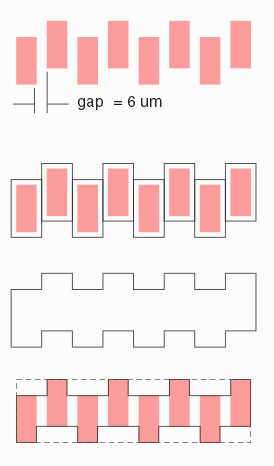





By using rule based selections, one can generate a large number of care areas.
For example, a large chip layout might generate 500,000 care areas. However the
wafer inspection system will have an upper limit that is often less than the
initial number of care areas generated. Some inspection machines have an upper
limit of 10,000 care while newer machines have an upper limit of 100,000 care
areas. In either case, if you start with 500,000 care areas you will have to
reduce that number.


The inspection system requires a certain minimum dimension for each care area.
This minimum value varies from machine to machine but it can range from about
2x2 um up to 5x5 um. If you pass a care area to the inspection system that is
too small it will be dropped. To avoid that, the CA Wizard can be instructed to
resize any care area to a mininmum size.


Both sizing and merging are done in during the export process and are controlled
using the Export dialog.




Merging care areas to reduce the overall count is complicated by the fact that a
certain amount of unwanted (i.e. don’t care areas) gets incorporated into the new output. The more reduction in
count, the more don’t care area is selected. The illustration below shows a typical problem.


After merging overlapping care areas we end up with a complex polygon. This must
be output as rectangles so a simple slicing algorithm can be used. However we
end up with more rectangles that we started with. Clearly this approach is not
suited to reducing the overall care are count.




The slicing approach also suffers from the possibility that some of the new
polygons are less than that minimum size.



Suppose, that instead of slicing the complex polygon we replace it with a
bounding box. This reduces the count from 4 to 1 but as you can see, there is a
lot of unwanted area now captured.





The algorithms used for merging are under continual review and will be updated
as more data files are analyzed and a better understanding of the tradeoffs
between count and unwanted inspection area is developed.


Sizing
Very often care areas are spaced slightly apart; to merge such areas they must
first be sized so that they touch or overlap. Because there may be different
spacings in X and Y the CA Wizard allows the user to specify these values
independently.




A series of care areas spaced along X by 6 um. We wish to consolidate this group
so we set a Gap value = 6


Each care area is sized up by 1/2 gap value on all edges. This causes them to
now touch.


The touching care areas are unionized to form a single polygon.


The polygon is sized down by 1/2 gap value and then replaced with a bounding
box.
























